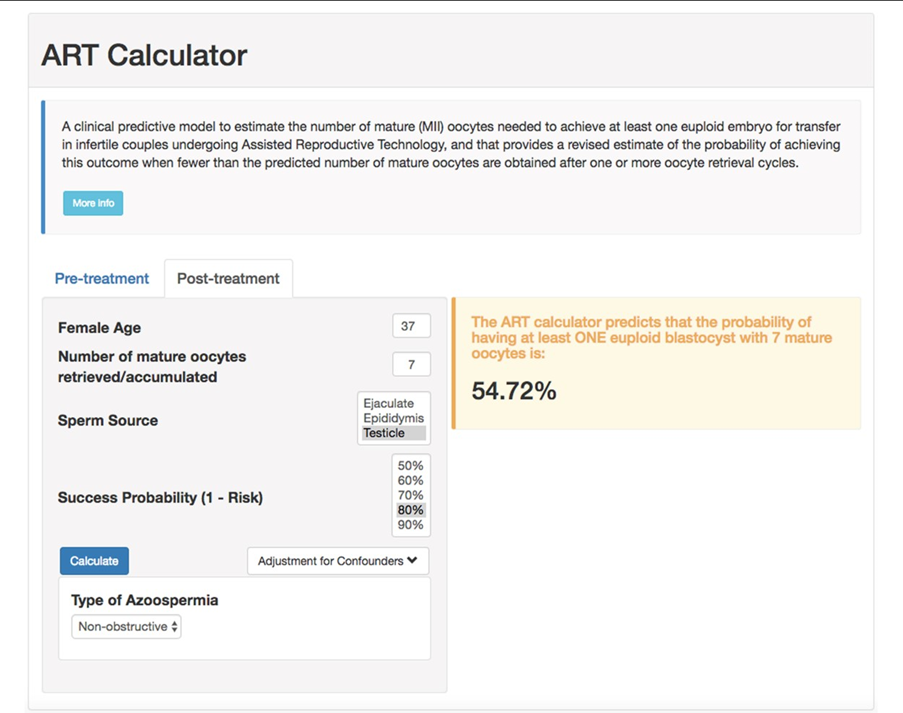How the Number of Eggs Affects IVF Success Rates

In an initial evolution in IVF treatment from 1978, the denominator of success rate change from implantation rate to clinical pregnancy rate to on-going pregnancy rate, which ends into live birth rate. In todays modern ART it further changes into per embryo transfer live birth rates. To address that we should at least know what will be the conversion of euploid embryo against numbers of matured egg (MII) retrieved from the different age group of females. So to find out that there was multicenter study evaluated the reliability of the recently published ART calculator for predicting the minimum number of metaphase II (MII) oocytes (MIImin) to obtain at least one euploid blastocyst in patients undergoing in vitro fertilization/intracytoplasmic sperm injection (IVF/ICSI). They used clinical and embryonic retrospective data of 1,464 consecutive infertile couples who underwent IVF/ICSI with the intention to have pre implantation genetic testing for aneuploidy. The validation procedure followed a stepwise approach.
ART success has been commonly reported as the delivery of a live birth resulting from one initiated or aspirated ART cycle. The most comprehensive studies indicate that there is a positive association between the number of retrieved oocytes and live birth rates (LBR), in particular, cumulative LBR, with higher oocyte thresholds for better outcomes. Although the LBR is the preferable endpoint for couples, it depends on a multitude of controlled and uncontrolled factors, thus making it challenging to use this metric for individualized predictions about the number of oocytes needed to achieve the desired outcome. In 2016, the POSEIDON (Patient-Oriented Strategies Encompassing IndividualizeD Oocyte Number) collaborative group introduced a new metric of success, namely, the ability to obtain the number of oocytes needed to achieve at least one euploid blastocyst for transfer. Besides the critical role of oocyte numbers on ART success, the transfer of euploid embryos markedly reduces the female age-related decrease in implantation rates, thus suggesting that the POSEIDON's marker might be a useful endpoint for clinicians providing care to infertility patients.
Recently, a clinical predictive model named “ART Calculator” was developed to estimate the number of metaphase II (MII) oocytes needed to achieve at least one euploid embryo for transfer in each patient undergoing ART. The model was built based on clinical and embryonic data of over 300 infertile couples who underwent in vitro fertilization/intracytoplasmic sperm injection (IVF/ICSI) and trophectoderm biopsy for preimplantation genetic testing for aneuploidy (PGT-A). The fitted model selected female age, sperm source –adjusted by type of azoospermia whenever appropriate–, and MII oocytes as predictors. A final logistic regression analysis model was developed based on the above predictors to estimate the probability of an MII oocyte become a euploid blastocyst as a function of female age and sperm source.
In practical terms, the estimations provided by the ART calculator should be analyzed according to the probability of success, denoted by “π” (e.g., 70%, 80%, 90%), set by the user. Based on the ART calculator, an exemplary patient of 35 years-old embarking on IVF/ICSI, whose male partner is non-azoospermic, requires a total of five (95% CI: 5–6), seven (95% CI: 6–9), and ten (95% CI: 9–13) MII oocytes to obtain at least one euploid blastocyst for 70, 80, and 90% probabilities of success.If all other factors are adequate, the cumulative pregnancy rates among patients who achieve the MIImin as per the calculator estimation should be 50–60% or higher.
The model is primarily intended to be a counselling tool for shaping patients' expectations and preparing them both emotionally and financially for the treatment journey. From a clinical and embryological perspective, the ART calculator outputs might also be used to help clinicians design individualized patient-oriented treatment strategies aiming at obtaining the number of MII oocytes needed for achieving at least one euploid blastocyst for transfer in IVF/ICSI procedures. The provision of such an objective estimation could help the clinician with regards to treatment planning. The individualized oocyte number may be achieved using patient-oriented strategies. For instance, the type of GnRH analog, type of gonadotropin, the starting dose, and the regimen could be tailored accordingly. A comprehensive review of the patient-oriented strategies encompassing individualized oocyte number can be found in a series of articles compiled in a dedicated Frontiers in Endocrinology research topic.
Limitation of this oocyte euploid embryo prediction calculator is that Baseline levels of FSH, sperm DNA fragmentation index, sperm morphology, and male BMI were excluded due to the inconsistent reporting by participating centers. Infertility duration, ethnicity, dietary patterns, smoking habits, alcohol consumption, history of previous pregnancy, and past PGT-A results were not taken into account as these predictors were not available in the dataset.
Although these predictors may have an impact on ART success, their role on blastocyst euploidy remains to be elucidated. By contrast, the most important predictors for blastocyst euploidy according to the existing evidence were assessed, including female age, male factor, and ovarian reserve markers. While other validation studies exist for predictive models concerning live birth after a single or multiple IVF/ICSI cycles, no validation study like ours exists to predict the minimum number of mature oocytes needed to achieve at least one euploid blastocyst for transfer.
Following Manual Calculation to get one Euploid Blastocyst by different number of egg in different age & side by this there is online calculator by Dr. Sandro Esteves which gives online info by entering female age, number of MII eggs & type of sperm.


Conclusion:
A novel calculator to predict the minimum number of metaphase II oocytes required to achieve at least one euploid blastocyst in the general population of infertile patients undergoing IVF/ICSI.
 Infertility Counselling
Infertility Counselling Female Infertility Treatment
Female Infertility Treatment Andrology Treatment
Andrology Treatment Fertility Enhancing Surgeries - Female
Fertility Enhancing Surgeries - Female Fertility Enhancing Surgeries - Male
Fertility Enhancing Surgeries - Male Endoscopy Treatment
Endoscopy Treatment IUI Treatment
IUI Treatment IVF Treatment
IVF Treatment ICSI Treatment
ICSI Treatment Advanced IVF Solutions
Advanced IVF Solutions Embryology
Embryology Vitrification Egg, Embryo, Sperm Freezing
Vitrification Egg, Embryo, Sperm Freezing Preimplantation Genetic Testing (PGT)
Preimplantation Genetic Testing (PGT) Donation Program Embryo / Egg / Sperm
Donation Program Embryo / Egg / Sperm Self-cycleTM IVF
Self-cycleTM IVF

 Self-cycleTM IVF
Self-cycleTM IVF










